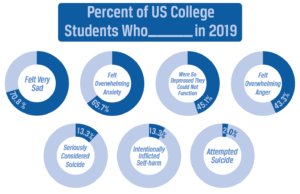5 Simple Steps to Leading a Happier Life

Written by: Abhinav Anne
Interviewed: Dr. Laurie Santos – Professor of Psychology at Yale University and Founder of the Happiness Lab
“Are we truly wired for happiness?” This question posed by Dr. Laurie Santos, a Professor of Psychology at Yale University and the Founder of the Happiness Lab, has been at the very forefront of her research. In a recent interview, she shared her insights on the science of happiness and the steps we can take to achieve it.
Dr. Laurie Santos
Dr. Santos is renowned for her work on the evolutionary origins of human cognition and is an expert on the science of happiness (Figure 1). She explores how our minds often deceive us about what makes us happy and how we can make wiser choices to lead a happier and more fulfilling life. Santos, having extensively studied the science of happiness, reveals that our instinctive strategies for improving our lives are often counterproductive. Her groundbreaking course at Yale University, “Psychology and the Good Life,” has captivated immense interest, becoming the most enrolled class in the university’s 300-year history, with nearly one out of every four students participating. This profound engagement reflects a widespread desire to understand and enhance well-being.
Figure 1

A Portrait of Dr. Laurie Santos
Source: Time Magazine
Expanding her influence beyond the classroom, Dr. Santos developed “The Happiness Lab” and its online counterpart, “The Science of Well-Being” on Coursera, which has drawn over 4 million learners globally. These platforms provide participants with insights into the latest happiness research, debunk widespread misconceptions about well-being, and highlight irrational thinking patterns that hinder happiness. The course, spanning ten weeks, equips students with scientifically validated methods for increasing personal happiness, encouraging a reevaluation of their beliefs and actions toward achieving a more satisfying life.
Unraveling the Pursuit of Happiness: Insights from Dr. Laurie Santos
Dr. Santos begins by challenging the common assumption that we are creatures built for happiness. “The sad thing is that we’re really not wired for happiness. Natural selection honestly doesn’t care how we feel- it really just wants us to survive and reproduce,” she explains. This revelation, while initially disheartening, sets the stage for a deeper understanding of our pursuit of happiness (Figure 2).
Figure 2

A Survey conducted by Brigham Young University regarding the Mental Health Status of US College Students
Source: Brigham Young University
In a world where about 45% of college students in the United States report being too depressed to function, it is crucial to understand the science behind happiness. According to Dr. Santos, our minds often deceive us into chasing things we believe will make us happy, a phenomenon psychologists call ‘miswanting.’ As she explains, “We experience what psychologists like Dan Gilbert and Tim Wilson have called ‘miswanting.’ The act of trying to go for certain things that we assume are gonna make us feel happy, but then they don’t make us as happy as we think.” You might think you know what it takes to lead a happier life… more money, a better job, or Instagram-worthy vacations. You’re dead wrong. In the pursuit of happiness, Dr. Santos suggests a five-step approach, referred to as “rewirements.”
Dr. Santos’s 5-Step Framework: The “Rewirements”
The first step is fostering social connections as individuals with lasting relationships often show stronger signs of happiness (Figure 3). “They physically spend time around other people and tend to prioritize time with their friends and family members,” Dr. Santos explains. Relationships play a pivotal role in our happiness, emphasizing the necessity of quality over quantity. Engaging in meaningful conversations, sharing experiences, and providing support enhances our connections and our own happiness. Making a conscious effort to spend quality time with loved ones, through simple activities like a shared meal or a phone call, can significantly impact our well-being.
Figure 3

Social interactions such as art classes can enhance one’s ability to connect with other individuals and destress
Source: Aspire Health
Next, she suggests engaging in selfless acts to improve one’s well-being. “Happy people are much more other-oriented. They’re donating more money to charity. They’re spending their time volunteering for others. They give more compliments,” she says. Performing acts of kindness benefits both the giver and recipient, fostering a sense of community. Incorporating small acts of kindness into daily routines cultivates happiness by reminding us of our positive impact on others.
The third step is practicing gratitude. “Lots of evidence suggests that happy people focus on the blessings. If you tend not to do that naturally, you can change that thought pattern,” Dr. Santos advises, recommending writing down three to five things you’re grateful for every night. This approach shifts our focus from what we lack to what we have, fostering a sense of abundance and a more optimistic outlook on life.
The fourth step is focusing on the good things in life ant not take it for granted. “The act of savoring is moving towards paying attention to the good things in life a little bit more,” Santos emphasizes. Being present and mindful in experiencing life’s joys, such as a beautiful sunset or a delicious meal, enhances our ability to find happiness in simple pleasures. By consciously engaging with moments of enjoyment, individuals cultivate a deeper appreciation for life’s small delights, fostering a sense of contentment and fulfillment. Practicing these techniques can help individuals build resilience and cope more effectively with life’s inevitable challenges, as they learn to draw strength and positivity from uplifting experiences.
The fifth and final step is engaging in physical activities to enhance the mind-body connection. “Exercise is intricately connected to our mental health, and it’s important to note that this isn’t like running a marathon. Even 20 minutes a day can improve your well-being,” she says, highlighting that moderate activities like walking or yoga can significantly improve mental health (Figure 4). Incorporating movement into our daily routine supports both physical and emotional well-being.
Figure 4

Even short sessions of exercise can greatly improve one’s mental health
Source: The New York Times
By weaving together these expanded insights, we create a comprehensive and nuanced understanding of Dr. Santos’ approach to enhancing happiness. Each step, enriched with additional details, underscores the intention and effort required to foster a happier, more fulfilling life through social connections, selfless acts, gratitude, savoring life’s moments, and physical activity.
A Personal and Proactive Journey
Understanding and implementing these steps toward happiness is crucial, especially in our fast-paced world where mental health issues are prevalent. However, it’s important to recognize that the journey to happiness is deeply personal and varies from one individual to another. While Dr. Santos’ five-step approach offers a structured path to enhancing well-being, integrating these practices into daily life requires commitment and mindfulness. It’s not merely about going through the motions but genuinely engaging with each step to foster a positive mindset. Additionally, embracing the full spectrum of human emotions, including the negative ones, as part of our growth and learning process is essential. By acknowledging our feelings, understanding their roots, and taking proactive steps toward happiness, we can navigate life’s challenges more effectively. This approach not only aids in achieving a happier state of mind but also enriches our overall life experience.
Conclusion
While these steps may seem simple, Dr. Santos warns that knowing them is not enough. “The real work is putting the things you learn into practice,” she says. By understanding the right things to do and actively implementing these “rewirements,” one can significantly change their level of happiness. It’s essential to remember that this process is ongoing and iterative. Happiness is not a destination; it’s a journey that involves continuous effort and adaptation. Engaging with these practices genuinely and consistently can lead to profound changes in how we experience life and our overall well-being.
References and Sources
The Science of Well-Being. (2018). Retrieved from https://online.yale.edu/courses/science-well-being
Dr. Laurie Santos, (2024). Retrieved from
https://www.drlauriesantos.com/
Why humans are surprisingly bad at being happy. (2023). Retrieved from https://bigthink.com/the-well/how-to-be-happy-415573/#:~:text=We%20experience%20what%20psychologists%20like,as%20happy%20as%20we%20think.